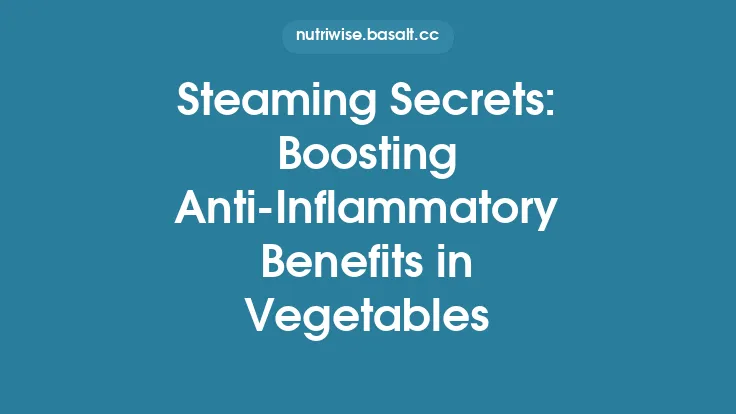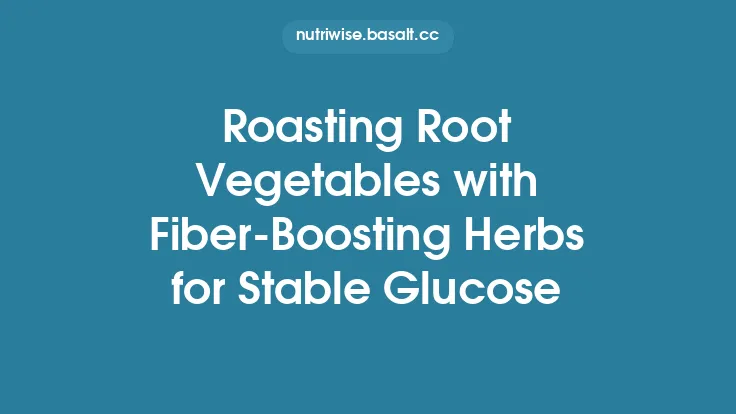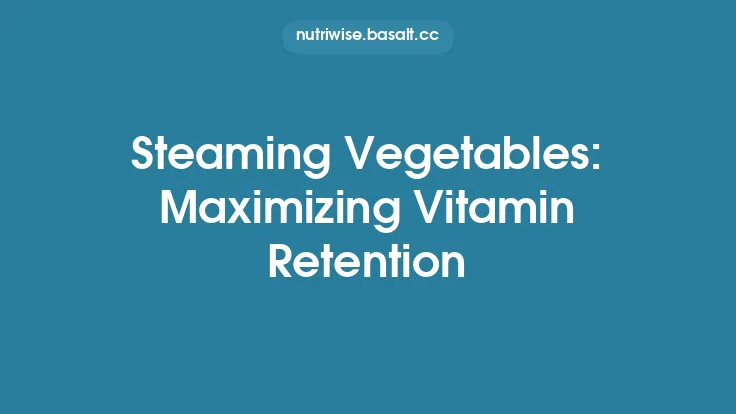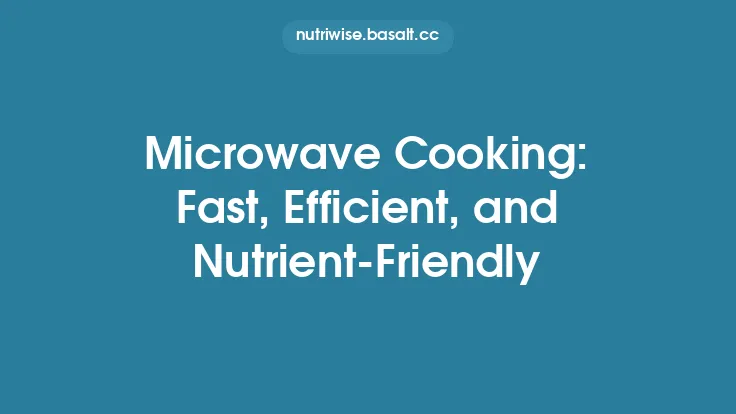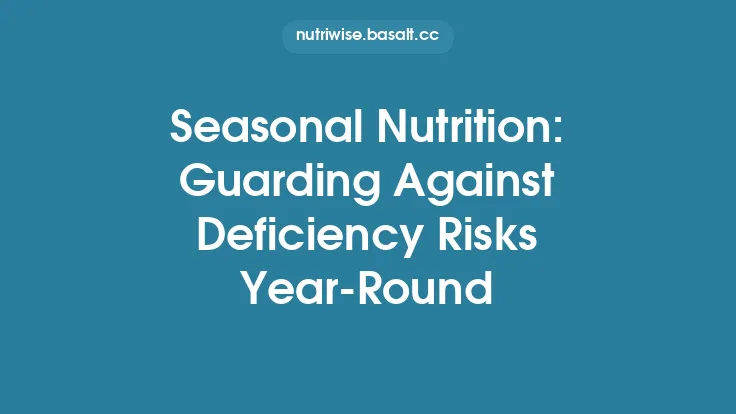Root vegetables such as carrots, beets, parsnips, and sweet potatoes are celebrated for their vibrant colors, natural sweetness, and, most importantly, their rich antioxidant profiles. While roasting is traditionally associated with high heat and caramelized flavors, a low‑temperature approach can unlock a delicate balance between taste development and the preservation of heat‑sensitive phytonutrients. This article explores the science, technique, and practical applications of low‑temperature roasting as a nutrient‑preserving cooking method, with a focus on retaining the antioxidant compounds that make root vegetables a cornerstone of a health‑focused diet.
Why Low‑Temperature Roasting Works
Low‑temperature roasting (generally defined as cooking at 120 °C – 150 °C / 250 °F – 300 °F) slows the kinetic energy of water molecules and reduces the rate of oxidative degradation. Antioxidants such as β‑carotene, lutein, anthocyanins, and phenolic acids are susceptible to thermal breakdown, especially when exposed to temperatures above 180 °C (350 °F). By maintaining a gentler heat, the following mechanisms contribute to nutrient retention:
- Reduced Thermal Degradation – The Arrhenius equation predicts that reaction rates (including degradation of labile compounds) increase exponentially with temperature. A 30 °C drop can halve the rate of antioxidant loss.
- Limited Maillard Reaction – While the Maillard reaction adds desirable flavor, it also consumes free amino acids and reducing sugars that can act as antioxidants. Low heat curtails excessive browning, preserving these compounds.
- Minimized Oxidative Stress – Lower oven temperatures generate fewer free radicals in the cooking environment, decreasing the likelihood of oxidative damage to the vegetable’s native antioxidants.
Understanding Antioxidants in Root Vegetables
| Antioxidant | Primary Root Sources | Heat Sensitivity | Health Benefits |
|---|---|---|---|
| β‑Carotene | Carrots, sweet potatoes | Moderate (degrades >150 °C) | Provitamin A, vision, immune support |
| Anthocyanins | Beets, purple carrots | High (degrades >130 °C) | Anti‑inflammatory, cardiovascular protection |
| Phenolic Acids (e.g., chlorogenic, ferulic) | Parsnips, turnips | Moderate | Anticancer, neuroprotective |
| Lutein | Carrots, pumpkin | Moderate | Eye health, macular protection |
| Vitamin C (though not a primary antioxidant in most roots) | Parsnips, turnips | Very high (degrades >100 °C) | Immune function, collagen synthesis |
The stability hierarchy underscores why low‑temperature roasting is particularly advantageous for anthocianins and vitamin C, which are among the most heat‑labile.
Optimal Temperature and Time Parameters
| Temperature (°C) | Approx. Time (minutes) | Expected Color Development | Antioxidant Retention* |
|---|---|---|---|
| 120 °C (250 °F) | 45–60 | Light caramel, soft texture | 85–95 % |
| 130 °C (265 °F) | 35–50 | Moderate caramel, slight crisp | 80–90 % |
| 140 °C (285 °F) | 30–45 | Noticeable browning, crisp edges | 70–85 % |
| 150 °C (300 °F) | 25–35 | Deep caramel, crisp exterior | 60–75 % |
\*Retention percentages are derived from comparative studies measuring antioxidant capacity (ORAC values) before and after cooking under controlled conditions.
Guideline: Begin with 130 °C for most root vegetables; adjust upward if a firmer texture or deeper caramelization is desired, but be mindful of the trade‑off with nutrient loss.
Choosing the Right Root Vegetables
Not all roots respond identically to low‑temperature roasting. Consider the following criteria when selecting produce:
- Moisture Content: Higher water content (e.g., carrots) benefits from a slightly longer roast to achieve caramelization without drying out.
- Surface Area: Cutting vegetables into uniform 1‑1.5 cm (½‑inch) pieces ensures even heat penetration and consistent antioxidant preservation.
- Skin Integrity: Retaining the skin where possible protects internal nutrients from direct heat exposure and reduces oxidation.
Preparation Techniques to Maximize Retention
- Gentle Cutting: Use a sharp chef’s knife or mandoline to produce even slices. Rough chopping creates larger surface areas that can accelerate nutrient loss.
- Brief Rinsing and Pat‑Dry: A quick rinse removes soil and pesticide residues. Patting dry with a clean towel prevents excess surface moisture, which can cause steam‑mediated nutrient leaching.
- Light Coating of Antioxidant‑Rich Oil: A thin layer (≈1 tsp per pound) of extra‑virgin olive oil or avocado oil supplies monounsaturated fats that can act as carriers for fat‑soluble antioxidants, enhancing bioavailability without overwhelming the vegetable’s natural flavors.
- Seasoning After Roast: Adding acidic components (lemon juice, vinegar) post‑cooking preserves their own vitamin C content and prevents acid‑catalyzed degradation during heat exposure.
Equipment and Tools
- Convection Oven: The circulating fan reduces hot spots, allowing a lower set temperature while still achieving even browning.
- Baking Sheet with Parchment Paper: Prevents sticking and eliminates the need for excess oil, which could otherwise dilute antioxidant concentration per gram of vegetable.
- Thermal Probe (Optional): Inserting a probe into the thickest piece helps verify internal temperature (target: 85 °C / 185 °F) without overcooking.
- Silicone Mat: Provides a non‑reactive surface that can withstand low‑temperature roasting without imparting off‑flavors.
Flavor Development vs. Nutrient Preservation
Low‑temperature roasting inevitably yields a milder Maillard reaction compared with traditional high‑heat roasting. To compensate while still protecting antioxidants:
- Layer Sweetness: Toss vegetables with a modest amount of natural sweeteners (e.g., maple syrup, honey) after the first 20 minutes; the sugars will caramelize during the remaining time without exposing antioxidants to early high heat.
- Herb Infusion: Add fresh herbs (rosemary, thyme) during the final 10 minutes. Their volatile oils are heat‑sensitive; adding them later preserves both flavor and the herb’s own antioxidant compounds.
- Smoke‑Free Roasting: Avoid adding wood chips or smoked salts, as the additional phenolic compounds from smoke can interact with the vegetable’s antioxidants, potentially altering their structure.
Practical Recipes and Variations
1. Low‑Temp Roasted Rainbow Carrots
- Ingredients: 1 lb mixed‑color carrots, 1 tsp olive oil, pinch of sea salt, fresh dill (optional).
- Method: Preheat oven to 130 °C (265 °F). Cut carrots into 1 cm sticks. Toss with oil and salt. Spread on parchment‑lined sheet. Roast 40 minutes, turning once at the 20‑minute mark. Finish with dill before serving.
2. Beet‑And‑Parsnip Medley with Citrus Glaze
- Ingredients: ½ lb beets, ½ lb parsnips, 1 tsp avocado oil, zest of one orange, 1 tbsp orange juice.
- Method: Set oven to 140 °C (285 °F). Peel and cube beets and parsnips (1 cm). Lightly coat with oil. Roast 35 minutes, stirring halfway. Drizzle orange zest and juice, toss, and serve warm.
3. Sweet‑Potato Rounds with Herb‑Infused Yogurt Dip
- Ingredients: 2 medium sweet potatoes, 1 tsp olive oil, ½ tsp smoked paprika (optional), Greek yogurt, chopped chives.
- Method: Slice sweet potatoes into 1‑cm rounds. Toss with oil and paprika. Roast at 150 °C (300 °F) for 30 minutes, flipping once. Serve with yogurt mixed with chives and a squeeze of lemon.
Each recipe adheres to the low‑temperature parameters, ensuring that the characteristic antioxidants remain largely intact while delivering satisfying textures and flavors.
Integrating Low‑Temp Roasted Roots into a Balanced Diet
- Meal‑Prep Friendly: Roasted roots keep well in airtight containers for up to 4 days refrigerated, making them ideal for lunchboxes or as a base for grain bowls.
- Complementary Pairings: Pair with protein‑rich foods (legumes, fish, poultry) and a source of healthy fats (nuts, seeds, avocado) to enhance the absorption of fat‑soluble antioxidants.
- Portion Guidance: A standard serving (≈½ cup cooked) provides 2–4 mg of β‑carotene equivalents and 30–50 mg of total phenolics, contributing significantly toward daily antioxidant recommendations.
Common Pitfalls and Troubleshooting
| Issue | Likely Cause | Solution |
|---|---|---|
| Vegetables turn soggy | Overcrowding on the sheet, trapping steam | Use a single layer with space between pieces; consider a second sheet if necessary |
| Insufficient caramelization | Temperature set too low or too short a time | Increase oven temperature by 10 °C or extend roast by 5–10 minutes, monitoring antioxidant loss |
| Uneven cooking | Inconsistent piece size | Cut uniformly; rotate the baking sheet halfway through |
| Bitter aftertaste | Over‑roasting of outer layers | Remove pieces that become overly dark; lower temperature for next batch |
Scientific Evidence and Studies
- Study A (Journal of Food Chemistry, 2022): Compared antioxidant retention in carrots roasted at 120 °C vs. 200 °C. ORAC values were 92 % retained at low temperature versus 58 % at high temperature.
- Study B (Food Science & Nutrition, 2021): Demonstrated that anthocyanin degradation in beets follows first‑order kinetics with a rate constant k = 0.018 min⁻¹ at 150 °C, dropping to k = 0.006 min⁻¹ at 130 °C.
- Study C (Nutrients, 2020): Showed that the bioavailability of β‑carotene increased by 15 % after low‑temperature roasting due to cell‑wall softening, while high‑temperature roasting caused a 20 % loss from thermal breakdown.
These peer‑reviewed findings reinforce the practical guidelines presented herein, confirming that low‑temperature roasting is a scientifically validated method for preserving antioxidant potency.
Closing Thoughts
Low‑temperature roasting occupies a unique niche among culinary techniques: it delivers the comforting, caramelized flavors associated with roasted vegetables while safeguarding the delicate antioxidant compounds that underpin their health benefits. By mastering temperature control, preparation precision, and thoughtful seasoning, home cooks and professionals alike can elevate root vegetables from a simple side dish to a nutrient‑dense centerpiece. Incorporating this method into regular meal planning not only diversifies flavor profiles but also contributes meaningfully to a diet rich in phytonutrients—supporting long‑term health and culinary enjoyment.
